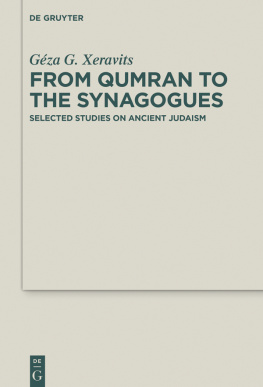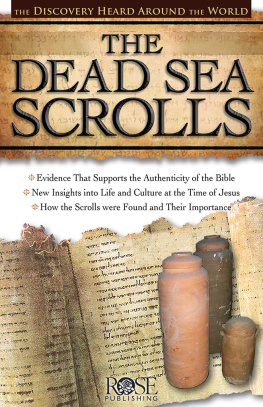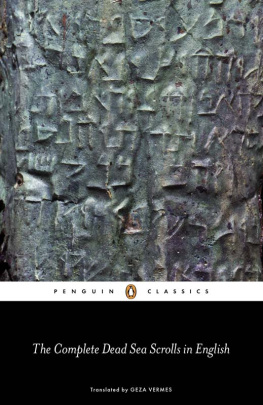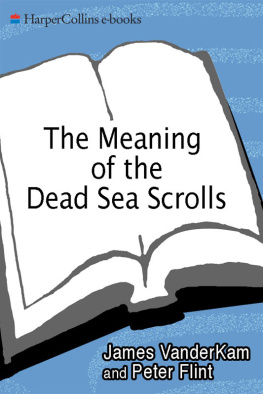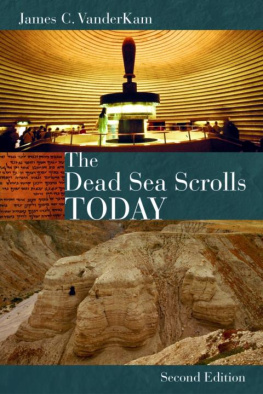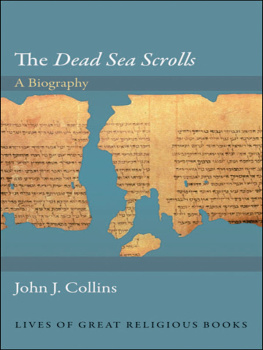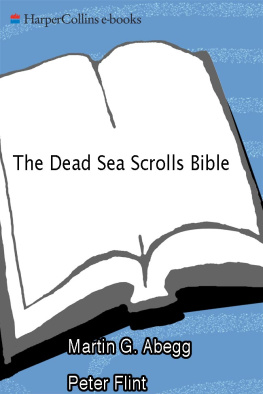Crawford proposes that Qumran functioned as an Essene library and scribal center, based on a comprehensive and balanced analysis of the Dead Sea Scrolls and the archaeological remains. Her highly readable and up-to-date overview will serve as a basic resource for scholars as well as an excellent introduction to the field for nonspecialists.
JODI MAGNESS ,
University of North Carolina at Chapel Hill
It is a pleasure to offer strong praise for Sidnie White Crawfords Scribes and Scrolls at Qumran . In it she offers a compelling case that Qumran and the nearby caves served as the scribal center and central library for the Essene wing of Judaism. She supports her thesis with thorough, up-to-date studies of scribes and libraries, the scrolls, their owners, and the archaeological evidence. The result is a comprehensive and appealing theory advanced by a scholar of unquestioned expertise in the field.
JAMES C. VANDER KAM ,
University of Notre Dame
This volume, by a leading Dead Sea Scrolls scholar, looks at the Dead Sea Scrolls and the site of Qumran from the perspective of the study of ancient books and libraries, an approach that results in important new proposals regarding the function of the site, the various caves, and the history of the collection. This novel approach will make this a must-read for anyone interested in the scrolls and their importance for the history of Judaism and the background of Christianity.
LAWRENCE H. SCHIFFMAN ,
New York University
This is an insightful, well-researched, contextual study that reaches broadly to archaeology and the salient evidence to understand the nature of the Dead Sea Scrolls and the reasons why they were placed in caves around Qumran. Crawford presents a much-needed holistic and synthetic view. This accessible and lively study is expertly crafted, judicious, and well-argued and will be essential reading for anyone studying the scrolls.
JOAN TAYLOR ,
Kings College London
Drawing on many decades of intense research, Sidnie White Crawford, a leading international expert on the Dead Sea Scrolls, has produced an impressively wide-ranging study on the state of play of research on the library and scribal profile of the texts and people reflected in the Dead Sea Scrolls, as well as offering her own comprehensive assessment of Qumran as home to the central library of the Essenes. This authoritative and admirably lucid and accessible volume makes an invaluable contribution to scholarship but will also serve excellently as a textbook for advanced students of the scrolls and is set to become a standard resource in the field.
CHARLOTTE HEMPEL , University of Birmingham
More than seventy years after the discovery of Cave 1, Sidnie White Crawford has offered a new synthesis of the archaeological and textual finds from Qumran. She writes as one who knows intimately both the archaeology of Qumran and the manuscripts from the caves. By placing the Qumran collection in the wider context of scribes and libraries of the ancient world, this study sheds important new light on the finds. Crawford masterfully details the richness of the library, from its content to the physical features of the manuscripts. At times her investigation reads like a mystery novel that the reader will find hard to put down. Piece by piece, Crawford assembles a compelling case for understanding the settlement at Qumran as a scribal center of the Essenes and the collection of texts as their central library. All future scholarly reconstructions of the Qumran sect will have to reckon with this study. This volume is a must-read for students and scholars of early Judaism alike.
CECILIA WASSN , Uppsala University
This book is the mature synthesis of the debates of the last generation that the field of Qumran studies has been waiting for. Sidnie White Crawford has eruditely assembled a very wide range of evidence from the caves, the Qumran site, and the manuscript finds, together with relevant comparative materials. She weighs that evidence judiciously, challenging, correcting, or endorsing a wide range of opinion. Overall, she courageously argues in a nuanced manner that the manuscript deposits in the eleven Qumran caves represent a single literary collection and that Qumran itself was established as a scribal center and library for the Essenes. The book will become a standard resource and reference point for the next generation.
GEORGE J. BROOKE , University of Manchester
Scribes and Scrolls at Qumran
Sidnie White Crawford
WILLIAM B. EERDMANS PUBLISHING COMPANY
GRAND RAPIDS , MICHIGAN
Wm. B. Eerdmans Publishing Co.
4035 Park East Court SE, Grand Rapids, Michigan 49546
www.eerdmans.com
2019 Sidnie White Crawford
All rights reserved
Published 2019
252423222120191234567
ISBN 978-0-8028-6620-2
eISBN 978-1-4674-5658-6
Library of Congress Cataloging-in-Publication Data
Names: Crawford, Sidnie White, author.
Title: Scribes and scrolls at Qumran / Sidnie White Crawford.
Description: Grand Rapids, Michigan : William B. Eerdmans Publishing Company, 2019. | Includes bibliographical references and index.
Identifiers: LCCN 2018060808 | ISBN 9780802866202 (pbk. : alk. paper)
Subjects: LCSH: Qumran community. | Essenes. | Scribes, Jewish. | Qumran Site (West Bank) | Dead Sea scrollsHistory.
Classification: LCC BM175.Q6 C655 2019 | DDC 296.8/15dc23 LC record available at https://lccn.loc.gov/2018060808
Unless otherwise indicated, all translated passages are from the following sources:
Bible: The New Revised Standard Version
Dead Sea Scrolls: The Dead Sea Scrolls Reader , 2 vols. Second Edition, Revised and Expanded, ed. by Donald W. Parry and Emanuel Tov (Leiden: Brill, 2014).
In Memoriam
Frank Moore Cross
(19212012)
John Strugnell
(19302007)
Contents
6.The Qumran Scrolls Collection:
A Scribal Library with a Sectarian Component
7.Who Owned the Scrolls?
The Qumran-Essene Hypothesis Revisited
Courtesy of Manchester Museum, The University of Manchester.
Qumranarchive Alexander Schick. www.bibelausstellung.de . Used with permission.
Dr. Avishai Teicher (Wikimedia Commons, CCA 2.5).
Qumranarchive Alexander Schick. www.bibelausstellung.de . Used with permission.
cole biblique. Used with permission.
Courtesy of Manchester Museum, The University of Manchester.
cole biblique. Used with permission.
cole biblique. Used with permission.
Qumranarchive Alexander Schick. www.bibelausstellung.de . Used with permission.
Qumranarchive Alexander Schick. www.bibelausstellung.de . Used with permission.
Qumranarchive Alexander Schick. www.bibelausstellung.de . Used with permission.
Qumranarchive Alexander Schick. www.bibelausstellung.de . Used with permission.
Courtesy of Manchester Museum, The University of Manchester.
Courtesy of Manchester Museum, The University of Manchester.
This volume has been many years in the making, and thus I have many institutions and people to thank. It is my pleasure to do so here. My editors at Wm. B. Eerdmans, Michael Thomson and Andrew Knapp, waited long past the original deadline for the manuscript. I thank them for their patience and their expert editing.
The University of NebraskaLincoln supported my research with both grants and in-kind support, in particular the Classics and Religious Studies Department, the Harris Center for Judaic Studies, and the Research Council. I spent a most pleasant semester at the Oxford Centre for Hebrew and Jewish Studies taking advantage of the superb research collection of the Bodleian Library. During the final stages of writing, the Institute for Research in the Humanities at the University of WisconsinMadison provided me with every scholars dream: a private office, an excellent library, and time to write with no distractions. I am deeply grateful to all of these institutions.
Next page

